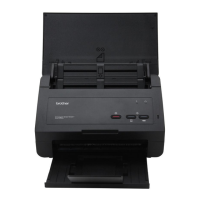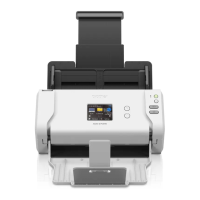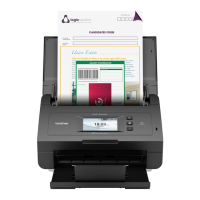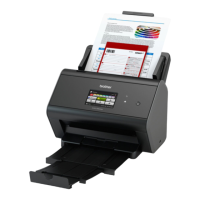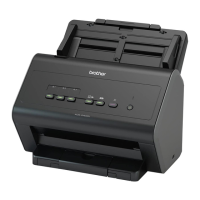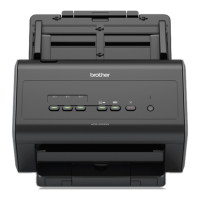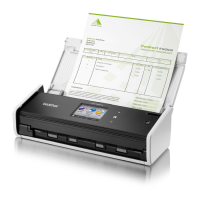Do you have a question about the Brother ADS-4300N and is the answer not in the manual?
Explains symbols and conventions used in the guide.
Lists trademarks of Apple, Kofax, Wi-Fi Alliance, etc.
States the product includes open-source software.
Contains copyright information.
Provides important notes on manuals, updates, and usage.
Identifies and labels the main parts of the scanner.
Provides instructions on how to attach the ADF and extend trays.
Explains the buttons and functions on the control panel for ADS-4300N.
Describes the home screens and icons on the touchscreen LCD.
Explains how to enter text using the touchscreen keyboard.
Details how to customize Home screens and manage restrictions.
Explains how to launch Brother Utilities for Windows.
Details acceptable document types, sizes, and weights.
Provides general instructions and warnings for loading documents into the ADF.
Lists applications for scanning without the control panel.
Lists various scanning methods and destinations available on the machine.
Explains different ways to scan using a Windows computer.
Explains different ways to scan using a Mac computer.
Describes how to adjust scan settings via Web Based Management.
Details network features supported by different operating systems.
Explains how to configure network settings.
Covers wireless network configuration options.
Lists network features like LDAP search and time synchronization.
Introduces Brother's tools for network settings.
Discusses network security protocols and recommends disabling FTP.
Explains how to configure certificates for secure SSL/TLS communication.
Covers secure communication using SSL/TLS protocols.
Explains IEEE 802.1x authentication for network access control.
Describes how to use Active Directory for machine access control.
Explains how to use LDAP for machine access and email address lookup.
Covers restricting access to machine operations and settings.
Explains how to prevent unauthorized access to machine settings.
Lists common error messages and their causes/actions.
Explains LED indications for machine status and errors.
Provides steps to clear document jams and prevent future jams.
Explains how to find the machine's serial number.
Details how to reset machine settings to factory defaults.
Provides instructions for cleaning the machine's exterior and interior parts.
Lists consumable parts and their replacement cycles.
Explains how to pack and ship the machine safely.
Explains how to adjust settings via the machine's control panel.
Describes how to change settings using a computer.
Lists technical specifications for the machine.
Provides information on chemical substances per REACH regulation.
Offers resources for product support and help.
| Color scanning | Yes |
|---|---|
| Grayscale levels | 256 |
| Input color depth | 48 bit |
| Maximum scan size | 215.9 x 355.6 mm |
| Output color depth | 24 bit |
| Output grayscale depth | 8 bit |
| ADF scan speed (b/w, A4) | 40 ppm |
| Enhanced scan resolution | 1200 x 1200 DPI |
| Optical scanning resolution | 600 x 600 DPI |
| Duplex ADF scan speed (b/w, A4) | 80 ipm |
| Output current | 1.9 A |
| Output voltage | 24 V |
| Power supply type | AC |
| AC input frequency | 50 - 60 Hz |
| Power consumption (off) | 0.1 W |
| Power consumption (sleep) | 1.7 W |
| Power consumption (standby) | 6.8 W |
| Power consumption (typical) | 24 W |
| Security algorithms | EAP-FAST, EAP-MD5, EAP-TLS, EAP-TTLS, HTTPS, PEAP, SMTP-AUTH, SNMPv3, SSL/TLS |
| Supported network protocols | DHCP, APIPA (Auto IP), WINS/NetBIOS, DNS Resolver, mDNS, SNMPv1/v2c/v3, ICMP, Web Services(Scan), HTTP/HTTPS server, LLMNR responder, SNTP Client, LDAP, RA, DNS Resolver, mDNS, LLMNR responder, Web Services(Scan), SNTP Client, HTTP/HTTPS server, ICMPv6 |
| Supported network protocols (IPv4) | DHCP, APIPA (Auto IP), WINS/NetBIOS, DNS Resolver, mDNS, SNMPv1/v2c/v3, ICMP, Web Services(Scan), HTTP/HTTPS server, LLMNR responder, SNTP Client, LDAP |
| Supported network protocols (IPv6) | RA, DNS Resolver, mDNS, LLMNR responder, Web Services(Scan), SNTP Client, HTTP/HTTPS server, ICMPv6 |
| Package depth | 320 mm |
| Package width | 391 mm |
| Package height | 243 mm |
| Package weight | 3320 g |
| Quantity per pack | 1 pc(s) |
| Control type | Buttons |
| Scanner type | ADF scanner |
| Product color | Black, White |
| Built-in display | No |
| Server operating systems supported | Windows Server 2012, Windows Server 2012 R2, Windows Server 2016, Windows Server 2019 |
| Storage temperature (T-T) | -20 - 60 °C |
| Operating temperature (T-T) | 5 - 35 °C |
| Storage relative humidity (H-H) | 10 - 90 % |
| Operating relative humidity (H-H) | 20 - 80 % |
| Scan to | FTP, Image, PC, SMB, USB |
| Sensor type | Dual CIS |
| Scan drivers | ICA, SANE, TWAIN, WIA |
| Scan file formats | JPEG, PDF, TIFF |
| Maximum duty cycle | 120000 pages per month |
| Scanning noise level | 59 dB |
| Daily duty cycle (max) | 6000 pages |
| Cables included | AC, USB |
| Auto document feeder (ADF) input capacity | 80 sheets |
| Maximum scan length | 5000 mm |
| Card thickness (max) | 1.1 mm |
| Paper tray media weight | 40 - 200 g/m² |
| Scanning media types supported | Business Card, Plain paper, Plastic Card, Recycled paper, Thick paper, Thin paper |
| Maximum ISO A-series paper size | A4 |
| USB version | 2.0/3.2 Gen 1 (3.1 Gen 1) |
| Sustainability certificates | RoHS |
| Certification | GS Mark ISIS WHQL KofaxTM 5, 10 VRS Elite 5.2.0 Kofax Express 3.3.0 |
| Harmonized System (HS) code | 84716070 |
| Depth | 215.9 mm |
|---|---|
| Width | 299.5 mm |
| Height | 190.5 mm |
| Weight | 2640 g |

